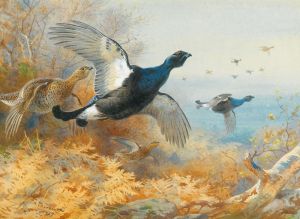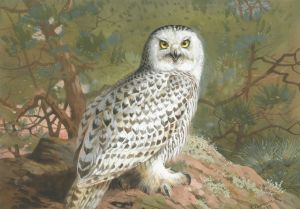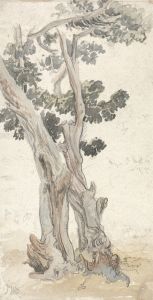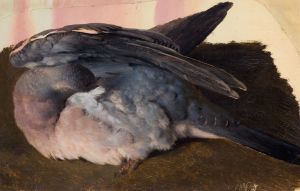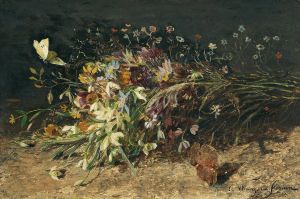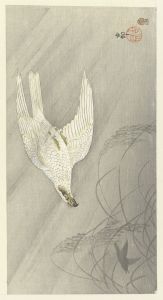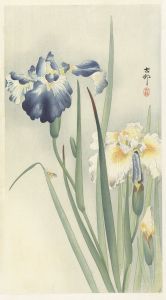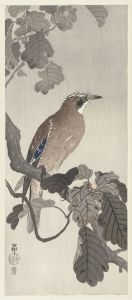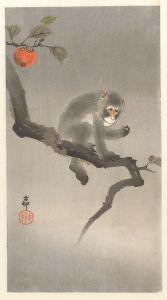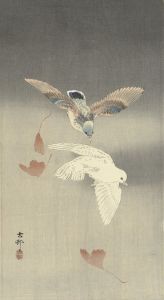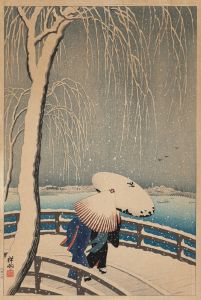
Two great tits at blossoming tree
A hand-painted replica of Ohara Koson’s masterpiece Two great tits at blossoming tree, meticulously crafted by professional artists to capture the true essence of the original. Each piece is created with museum-quality canvas and rare mineral pigments, carefully painted by experienced artists with delicate brushstrokes and rich, layered colors to perfectly recreate the texture of the original artwork. Unlike machine-printed reproductions, this hand-painted version brings the painting to life, infused with the artist’s emotions and skill in every stroke. Whether for personal collection or home decoration, it instantly elevates the artistic atmosphere of any space.
Ohara Koson (1877–1945) was a prominent Japanese artist known for his exquisite woodblock prints, particularly those depicting birds and flowers, a genre known as kachō-e. His works are celebrated for their delicate beauty, attention to detail, and the harmonious balance between subject and background. One of his notable works is "Two Great Tits at Blossoming Tree," which exemplifies his mastery in capturing the essence of nature.
This artwork features two great tits, a species of bird known for its vibrant plumage and lively demeanor, perched on the branches of a blossoming tree. The composition is a fine example of Koson's ability to blend realism with artistic expression. The birds are depicted with meticulous attention to detail, showcasing their distinctive markings and colors, which are rendered with subtle gradations and a keen eye for naturalistic representation.
The blossoming tree serves as a backdrop that enhances the overall aesthetic of the piece. The flowers are depicted in full bloom, with delicate petals that add a sense of vibrancy and life to the scene. The use of color is particularly noteworthy; Koson employs a palette that is both vivid and harmonious, capturing the ephemeral beauty of the blossoms and the lively presence of the birds.
Koson's work is deeply rooted in the traditions of the ukiyo-e movement, which flourished in Japan from the 17th to the 19th centuries. However, he was also part of the shin-hanga ("new prints") movement, which sought to revitalize traditional Japanese woodblock printing by incorporating Western techniques and perspectives. This movement emerged in the early 20th century and aimed to appeal to both Japanese and international audiences. Koson's prints, including "Two Great Tits at Blossoming Tree," reflect this synthesis of traditional and modern elements, making them appealing to a wide range of art enthusiasts.
The artist's collaboration with publishers such as Watanabe Shōzaburō played a significant role in the dissemination of his work. Watanabe was instrumental in promoting the shin-hanga movement and helped bring Koson's prints to a global audience. This partnership ensured that Koson's art was not only appreciated in Japan but also found admirers in Europe and America, where there was a growing interest in Japanese art during the early 20th century.
"Two Great Tits at Blossoming Tree" is a testament to Koson's skill in capturing the fleeting beauty of nature. His ability to convey the delicate interplay between the birds and their environment speaks to his deep appreciation for the natural world. The print is a celebration of life and the changing seasons, themes that are central to much of Japanese art and culture.
Today, Ohara Koson's works are highly sought after by collectors and are held in prestigious museums and private collections worldwide. His prints continue to be admired for their technical excellence and their ability to evoke a sense of tranquility and wonder. "Two Great Tits at Blossoming Tree" remains a quintessential example of Koson's artistry, embodying the grace and elegance that define his contributions to the world of Japanese woodblock prints.





